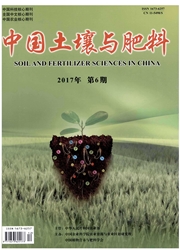

 中文摘要:
中文摘要:
Soil organic carbon(SOC) and soil Olsen-P are key soil fertility indexes but information on their relationships is limited particularly under long-term fertilization. We investigated the relationships between SOC and the percentage of soil Olsen-P to total P(PSOPTP) under six different 15-yr(1990-2004) long-term fertilizations at two cropping systems in northern China. These fertilization treatments were(1) unfertilized control(control);(2) chemical nitrogen(N);(3) N plus chemical P(NP);(4) NP plus chemical potassium(NPK);(5) NPK plus animal manure(NPKM) and(6) high NPKM(hNPKM). Compared with their initial values in 1989 at both sites, during the 11th to 15th fertilization years annual mean SOC contents were significantly increased by 39.4-47.0% and 58.9-93.9% at Gongzhuling, Jilin Province, and Urumqi, Xinjiang, China, under the two NPKM fertilizations, respectively, while no significant changes under the no-P or chemical P fertilization. During the 11th to 15th fertilization years, annual mean PSOPTP was respectively increased by 2.6-4.2 and 5.8-14.1 times over the initial values under the two chemical P fertilizations and the two NPKM fertilizations, but was unchanged in their initial levels under the two no-P fertilizations at both sites. Over the 15-yr long-term fertilization SOC significantly positively correlated with PSOPTP(r2=0.55-0.79, P<0.01). We concluded that the combination of chemical P plus manure is an effective way to promote SOC accumulation and the percentage of soil Olsen-P to total P at the two mono-cropping system sites in northern China.
 英文摘要:
英文摘要:
Soil organic carbon (SOC) and soil Olsen-P are key soil fertility indexes but information on their relationships is limited particularly under long-term fertilization. We investigated the relationships between SOC and the percentage of soil Olsen-P to total P (PSOPTP) under six different 15-yr (1990-2004) long-term fertilizations at two cropping systems in northern China. These fertilization treatments were (1) unfertilized control (control); (2) chemical nitrogen (N); (3) N plus chemical P (NP); (4) NP plus chemical potassium (NPK); (5) NPK plus animal manure (NPKM) and (6) high NPKM (hNPKM). Compared with their initial values in 1989 at both sites, during the 1 lth to 15th fertilization years annual mean SOC contents were significantly increased by 39.4-47.0% and 58.9-93.9% at Gongzhuling, Jilin Province, and Urumqi, Xinjiang, China, under the two NPKM fertilizations, respectively, while no significant changes under the no-P or chemical P fertilization. During the 1 lth to 15th fertilization years, annual mean PSOPTP was respectively increased by 2.6-4.2 and 5.8-14.1 times over the initial values under the two chemical P fertilizations and the two NPKM fertilizations, but was unchanged in their initial levels under the two no-P fertilizations at both sites. Over the 15-yr long-term fertilization SOC significantly positively correlated with PSOPTP (r^2=0.55-0.79, P〈0.01). We concluded that the combination of chemical P plus manure is an effective way to promote SOC accumulation and the percentage of soil Olsen-P to total P at the two mono-cropping system sites in northern China.
 同期刊论文项目
同期刊论文项目
 同项目期刊论文
同项目期刊论文
 Greenhouse gas emissions and stocks of soil carbon and nitrogen from a 20-year fertilised wheat-maiz
Greenhouse gas emissions and stocks of soil carbon and nitrogen from a 20-year fertilised wheat-maiz How do environmental factors and different fertilizer strategies affect soil CO2 emission and carbon
How do environmental factors and different fertilizer strategies affect soil CO2 emission and carbon Soil organic carbon sequestration in upland soils of northern China under variable fertilizer manage
Soil organic carbon sequestration in upland soils of northern China under variable fertilizer manage Evaluation of the CENTURY Model Using Long-Term Fertilization Trials under Corn-Wheat Cropping Syste
Evaluation of the CENTURY Model Using Long-Term Fertilization Trials under Corn-Wheat Cropping Syste Testing the modified Rothamsted Carbon Model for paddy soils against the results from long-term expe
Testing the modified Rothamsted Carbon Model for paddy soils against the results from long-term expe Contributions of wheat and maize residues to soil organic carbon under long-term rotation in north C
Contributions of wheat and maize residues to soil organic carbon under long-term rotation in north C Modelling and Predicting crop yield, soil carbon andnitrogen stocks under climate change scenarios w
Modelling and Predicting crop yield, soil carbon andnitrogen stocks under climate change scenarios w 期刊信息
期刊信息
